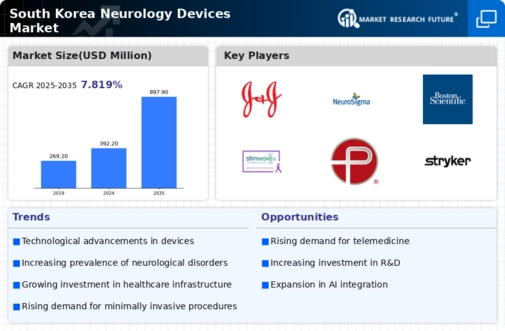Growing Awareness and Education
There is a growing awareness of neurological disorders and the importance of early diagnosis and treatment in South Korea. Educational campaigns and initiatives by healthcare organizations are informing the public about the symptoms and risks associated with neurological conditions. This heightened awareness is leading to an increase in patient consultations and, consequently, a higher demand for neurology devices. As more individuals seek medical advice, the neurology devices market is expected to benefit from this trend, with an anticipated growth rate of around 7% over the next few years.
Increased Healthcare Expenditure
The rising healthcare expenditure in South Korea is a significant driver for the neurology devices market. With the government and private sectors investing more in healthcare, the total healthcare spending is projected to reach around $200 billion by 2026. This increase in funding allows for the procurement of advanced neurology devices, which are essential for effective diagnosis and treatment of neurological conditions. Furthermore, as healthcare policies evolve to prioritize mental health and neurological disorders, the demand for specialized devices is likely to grow, thereby enhancing the market's potential.
Regulatory Support and Framework
The regulatory environment in South Korea is becoming increasingly supportive of the neurology devices market. The government has implemented policies aimed at expediting the approval process for new medical devices, which encourages innovation and market entry. This regulatory support is crucial for manufacturers looking to introduce cutting-edge neurology devices. With a streamlined approval process, companies can bring their products to market more quickly, thereby meeting the growing demand for advanced neurological care. As a result, the neurology devices market is likely to experience accelerated growth, driven by the influx of new technologies.
Rising Incidence of Neurological Disorders
The increasing prevalence of neurological disorders in South Korea is a primary driver for the neurology devices market. Conditions such as Alzheimer's disease, Parkinson's disease, and epilepsy are becoming more common, with estimates suggesting that around 1.5 million individuals are affected by these disorders. This rising incidence necessitates the development and adoption of advanced neurology devices for diagnosis and treatment. The market is projected to grow at a CAGR of approximately 8.5% over the next five years, driven by the demand for innovative solutions that enhance patient outcomes. As healthcare providers seek to improve the quality of care, investments in neurology devices are likely to increase, further propelling market growth.
Technological Innovations in Device Development
Technological advancements play a crucial role in shaping the neurology devices market. Innovations such as brain-computer interfaces, advanced neuroimaging techniques, and minimally invasive surgical tools are transforming the landscape of neurological care. In South Korea, companies are investing heavily in research and development, with expenditures reaching approximately $500 million annually. These innovations not only improve the efficacy of treatments but also enhance patient comfort and recovery times. As the demand for more sophisticated and effective devices rises, the neurology devices market is expected to expand significantly, with new products entering the market regularly.



















Leave a Comment